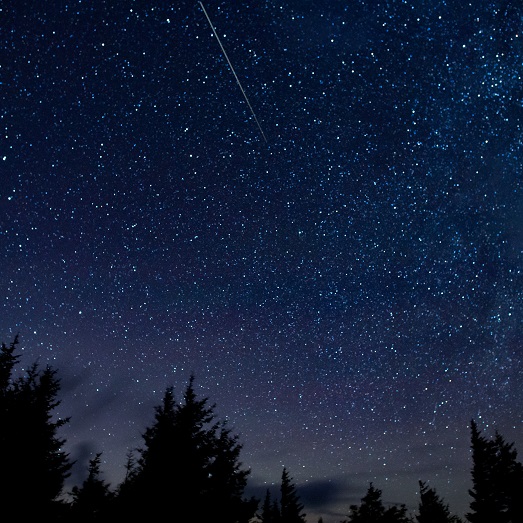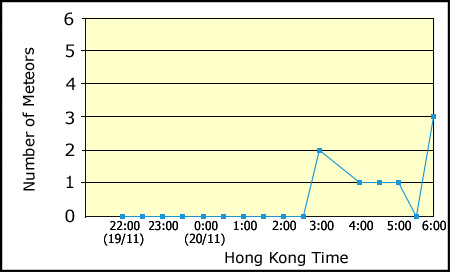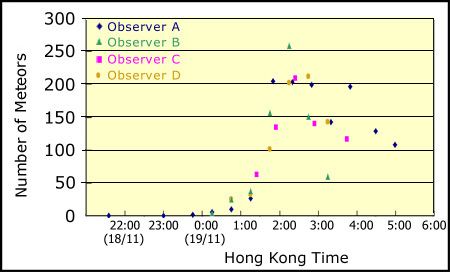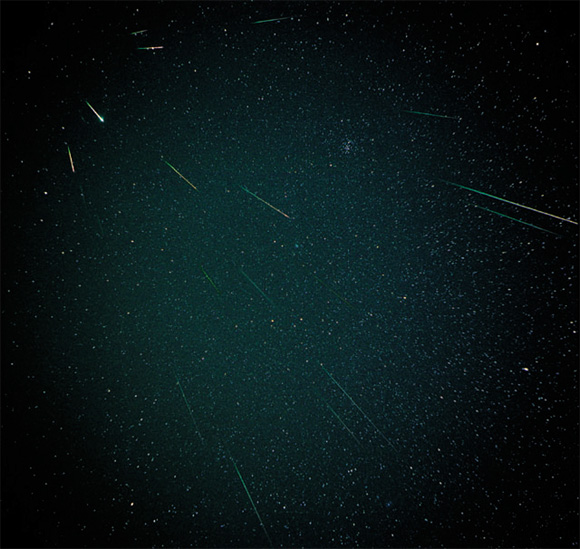 Web Content Display
Web Content Display

Meteor Shower
Tab Menu
 Web Content Display
Web Content Display
The Leonid Meteor Shower in 2004 was a unspectacular one. The maxima at dawn on 20th November did not happened as predicted. According to the preliminary result of International Meteor Organization, the highest rate of Leonids was only slightly above 30, which is the level of an ordinary year.

Each dot represents the number of every 30 minutes (For general reference only)
 Web Content Display
Web Content Display
People in Hong Kong and other countries should be impressed by the Leonid Meteor Shower occurred in 19th November, 2001.
Here we integrate the observation results of worldwide and local observers. The shower had two prominent peaks, which happened in North America and East Asia. Observers in Northern America and Canada counted around 500 meteors per hour during the first maxima, while those located in China and South East Asia observed more than a thousand!

Hong Kong was one of the best locations to for the 2001 Leonids. Together with the good weather, the citizen witnessed an astronomical phenomenon which may be the most splendorous they had ever experienced in their lives. Nonetheless, the light pollution in Hong Kong is too severe to let us appreciate as many meteors as citizen in suburb Beijing did.
Few nights before the maxima, only sparse meteors streaked across the sky, and one might wonder if the prediction by astronomers would be just a science fiction. However, when the good news of the successful observation of the first maxima came out, the faith of the observers in East Asia was strengthen. While seeing the earth gazers streaked across the sky with a long trail just after midnight of 19th, we knew the astronomers did not disappoint us. Around 2:15am, fans at suburb locations in Hong Kong saw seven to eight meteors pouring from the sky, sometimes up to five meteors emerged from the radiant all at once. Even people in urban districts could also see two to three meteors per minute. And most of them were bright fireballs that shined below magnitude 0. Many people noticed the red head and green trail of the meteor. Colour of the meteor is an important clue to understand the composition of the meteoroid.
| Element | Colour |
|---|---|
| Sodium | Orange-yellow |
| Iron | Yellow |
| Magnesium | Bluish-green |
| Calcium | Violet |
| Silicon | Red |
Compare with 1998, the 2001 Leonids was even more numerous, and the proportion of fireballs were higher. However, explosives ones which illuminate ground objects, leave a smoky train, or even produce cracking sound, are much less than 1998 shower.

(Each dot represents the number of every 30 minutes)
※For general reference only
Lion Rock and Leonids (Edited Video Clips)
| Date: | 19-11-2001 |
|---|---|
| Time: | 2:00 - 4:00 (Hong Kong Time) |
| Location: | Homantin, Kowloon, Hong Kong |
| Orientation: | North (Lion Rock can be seen on the bottom.) |
| Video Camera: | DV camera (f=4.2mm, equivalent to 48mm in SLR camera) |
| Video mode: | Normal mode at the beginning, night vision mode at the later portion. |
| By: | Yip Chee Kuen |

Leonids From the Radiant (9 Frames Composite)
| Date: | 19-11-2001 |
|---|---|
| Time: | 1:30-3:00 (Hong Kong Time) |
| Location: | Sai Wan, Sai Kung |
| Camera: | 120 Twin Lens Reflex (f=28mm) at F/4 |
| Film: | ISO 400 color negative |
| Exposure: | 10 mins per frame (tracked exposure) |
| Photographer: | Lau Kai Ip |
